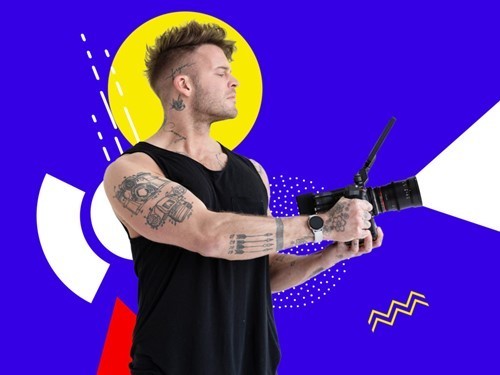Looking back, I wish I’d had some solid advice from my peers when I was starting out as a cinematographer. Instead, I pretty much had to learn on the job. And while this was – and is – an incredibly important way of picking up essential skills, I always felt like I was playing catch up.
To save aspiring cinematographers like you the trouble, here are five key things I’ve learnt over the last 15 years of shooting engaging videos.
1. Boo! Don’t Be Afraid Of The Dark
You’ll hear time and time again that you need to use as much light as possible for maximum results. This is somewhat true, but I tend to go the opposite way. I start with as little light as possible and work my way up.
More often than not I find myself in situations where it’s just not possible to have HMIs (lamps) knocking about and sparks on hand (people who sort lighting out on a set). My style is all about low-key lighting for a more dramatic effect.
So don’t be scared to whack those aperture blades wide open and crank the ISO up.
2. It’s Okay To Wing It (Well, Sometimes)
Yes, yes, I’ve made countless YouTube videos highlighting the importance of pre-production planning and preparation. And, yes, yes, my motto is, “fail to prepare, prepare to fail”.
But, you know what? Winging it can often yield some of your best shots, moments and performances. The director, Zach Snyder, for example, is a big fan of ‘Happy Accidents’ and often keeps ‘super organic’ moments in the final films because of the unique quality they bring.
So don’t delete those takes, they might just be your Snyder Cut. And one more thing – happy accidents also happen in post, when you’re editing, with lucky cuts you didn’t plan for.
3. Get Up In People’s Grill (Respectfully That Is)
One of my biggest assets is the ability to make people around me feel comfortable. I do this by being me, which pretty much means cracking jokes and being sarcastic.
This allows me to ‘test the water’ and, effectively – and in a good way – encourage subjects to drop their guard. The results are more intimate shots and details that others with a camera in their hand miss out on.
You need to really feel what you’re shooting
And the more comfortable people are, the more natural they appear on-screen. And when people begin to open up… boom! You’re talking about content gold.
4. It’s All About Leading Lines (Not Spoken Ones)
I’m a sucker for symmetry, leading lines and looking-space. Nail these and you’re on to a good thing. After all, if ain’t broke…
What I’m talking about is good composition. If you can’t master the art of framing a shot, it won’t matter how perfect your light is or the happy accidents you experience. Bad composition is a wrecking ball.
My biggest tip here is that you need to really feel what you’re shooting. Are you looking for an emotional shot but filming super wide and can’t see those tears? Well, frame accordingly. Think about how you would see these moments through your own eyes.
5. Equipment Does In Fact Matter (In My Opinion)
Over the years, my style has, in part, evolved because of my relationship with RED cameras. Because I understand how they work inside and out, I’ve been able to push the boundaries of my cinematography and develop a style that I can’t really duplicate with another camera.
For example, the sensor size is an s35, which affects the glass focal length. I’ve used that to develop a particular style. Likewise, because the resolution is 8K, I’m able to push things further in terms of light and noise that I can’t elsewhere. And the R3D codec – basically the file format – allows me to make any shot my own in post.
So, as you can see, what your equipment ‘lets’ you do, is hugely important. That’s not to say it’s the be-all and end-all. Give me any camera, and I’ll give you high-quality, cinematic footage. Behind every good camera, after all, is a great cinematographer.
Key Takeaways For Aspiring Cinematographers
Don’t be afraid of trying new things, winging it, going against the norm and messing up Don’t be afraid to get close and personal to your subject, but do it with a level of charm and thoughtfulness Don’t be afraid to follow the norm too. If it works for other people, then don’t be scared of making it work for you Don’t be afraid of defining your style with the help of a particular camera And worry about failing. This is one of my biggest lessons learnt. Failing helps you learn, improve and growWith Viddyoze, aspiring cinematographers can add powerful transitions, intros and outros to their videos. Find out more here.























